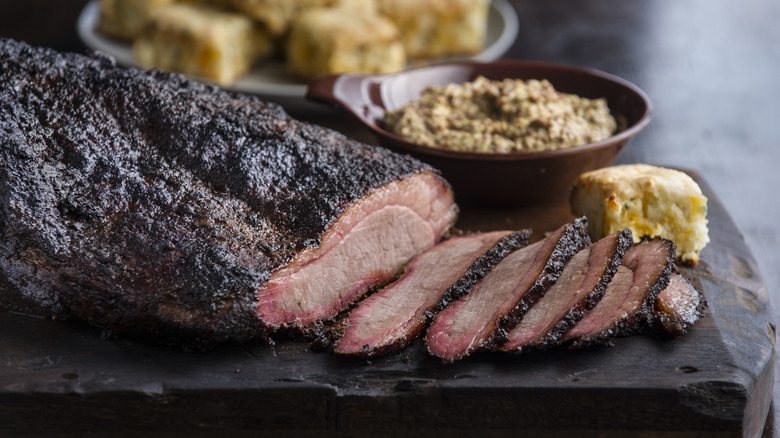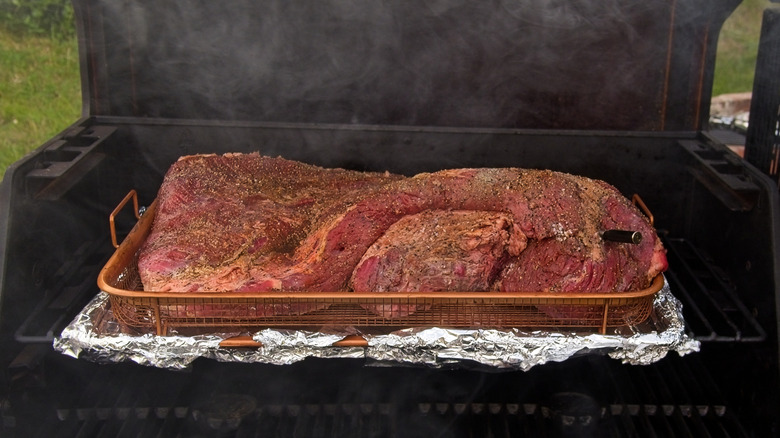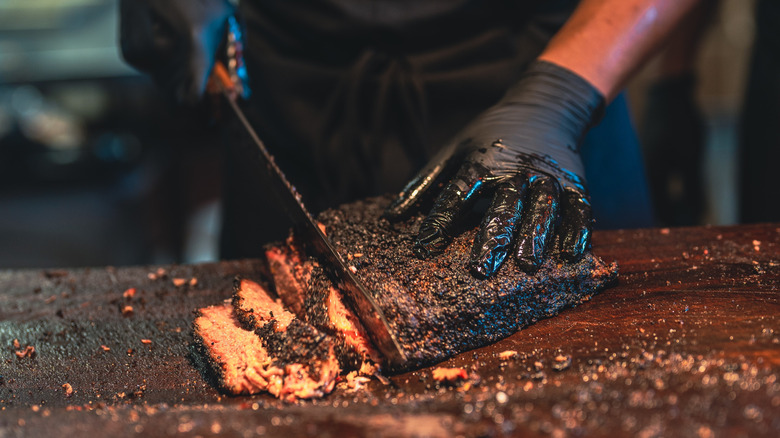How To Make Tender Smoked Brisket (Without The 3-2-1 Method)
For barbecue enthusiasts, a great brisket is the holy grail. It's often an elusive thing, taking some years of experience, trial and error, and practice to get right. Indeed, there's also an awful lot of what seems like alchemy — or perhaps even witchcraft — at play in the brisket world, and it can be hard to decipher some of the myriad of techniques different barbecue enthusiasts swear by for their version of the perfect brisket. Armchair pit masters everywhere have a habit of throwing around tips and tricks that are at best unhelpful — and at worst downright wrong. So how do you know what to believe?
If there even is a secret to the perfect brisket, many on the internet would have you believe that it's the so-called "3-2-1 method." This is a method of smoking originally devised for cooking ribs — for which it really does work very well — and happens to be very easy, so it's natural that eventually it made its way to brisket, too.
Essentially, it simplifies the cooking process of your brisket into three stages: The first, three hours of smoking unwrapped, followed by two hours of smoking after wrapping the brisket and basting it in liquid, before unwrapping the brisket again for a final hour in the smoker to sure up the bark and finish off the cook. While it makes for a decent method for novice barbecuers, simple and easy to remember as it is, most pit masters don't recommend using it, especially when learning to smoke.
The problems with the 3-2-1 method of smoking brisket
Though the 3-2-1 method is an easy to remember technique that can be useful for beginner pit masters, it's hardly an ideal technique when it comes to smoking a really great brisket. If we're being really honest, beginners should probably avoid it, too. It's much better to learn the right way to smoke a brisket from the start, rather than getting used to a hard and fast rule that doesn't always work. The problem is that methods relying on fixed timelines just aren't particularly effective, they're one-size-fits-all solutions, but not all briskets are alike. Indeed they often vary in size, weight, and makeup when it comes to fat and meat.
For one, you can risk overcooking — or even undercooking — your brisket. The 3-2-1 method was designed for ribs, not brisket, a far less dense meat, and importantly, one on the bone, which ensures it stays moist throughout the cooking process. Simply applying the same technique to brisket runs the risk of dry, overcooked meat.
Then, there's the matter of when to wrap your brisket. Per the 3-2-1 method, you should be wrapping your brisket after it's been smoking for three hours. Again, this method just isn't precise enough for properly good brisket. If you wrap your brisket too early — or for too long, you risk steaming your bark, not smoking it, leaving you with a sad, soggy texture, rather than the lovely crisp, peppery exterior you're looking for.
The best methods to use for a perfect smoked brisket
Though you shouldn't really use a one-size-fits-all method when it comes to cooking time, there are a few guidelines you can follow when it comes to temperature. Just like cooking any other meat — be it a foolproof roast chicken or a delicious steak, keeping a precise eye on internal temperature can ensure a perfect cook every time, and is far more reliable than relying on time alone. For the best idea of how long to cook brisket, put down your timer, and pick up a thermometer.
After trimming the perfect amount of fat cap from the brisket, smoke it between 225 and 250 degrees Fahrenheit, unwrapped, until the internal temp reaches 165 to 170 degrees Fahrenheit. Most importantly, make sure the bark is well formed, something that can take hours (sometimes far longer than the three hours the 3-2-1 method prescribes) depending on the size of your brisket.
Only then should you wrap it in butcher paper, and continue smoking until the temp reaches 195 to 203 degrees Fahrenheit. This allows for the fat and tissue in the brisket to effectively break down, ensuring juicy, tender meat. Finally, and perhaps most importantly, rest your brisket, for at least an hour, but up to two. This will allow the juices to equally redistribute throughout the meat, leaving you with equally moist, evenly delicious brisket.


